Home
A comprehensive resource for safe and responsible laser use
US: Air Force develops laser glare protection glasses for pilots
Washington State Patrol pilots successfully test special laser eye protection developed at Wright-Patterson Lab
Story by Mary Pacinda, Air Force Research Laboratory
Aiming a laser at an aircraft is a federal crime that can net offenders up to five years in jail or cost them a $250,000 fine. Even with this heavy potential penalty, laser strikes have become increasingly more common. According to the FAA, 6,852 such incidents were reported in 2020, compared with 385 in 2006, and so far this year, incidents of “joy lasing” are up 20 percent over last year. Cheap and easily obtained, hand-held lasers used as pointers and cat toys are certainly harmless when used as intended. But when they are aimed at the cockpit of an aircraft, they can temporarily blind the pilot — with possibly deadly consequences.
Laser strikes are almost always made at low altitudes when an aircraft is taking off or preparing to land — the two parts of flying that require the most attention from a pilot. Even if the beam of light does not hit the pilot’s eyes directly, it can cause a distraction or even raise an alarm that the plane may have become a target. In addition to the possible adverse effects of these human reactions, slight imperfections in the plane’s windscreen can cause the laser light to spread out, creating a glare that can temporarily obscure all vision inside the cockpit.
Of course, passing a law against any behavior — including pointing a laser at an airplane — seldom puts an end to the behavior. Thus, the best way to avoid disaster from laser strikes is to provide some sort of protection for the pilot. As a result, in recent years several manufacturers have developed laser eye protection (LEP) to meet a growing demand for help from military and law enforcement pilots. But this solution is not without problems of its own.
Most laser eye protection works by filtering out green or red light, the colors most commonly used in handheld lasers. Unfortunately, according to FAA studies and years of pilot experience, this can change the pilot’s ability to accurately read the instrument control panel. A 2019 FAA report suggested that this problem might be fixed by changing the type of lighting in the control panel.
Researchers at the Air Force Research Laboratory recently came up with a better solution, one that was successfully tested on the job by Washington State Patrol pilots.
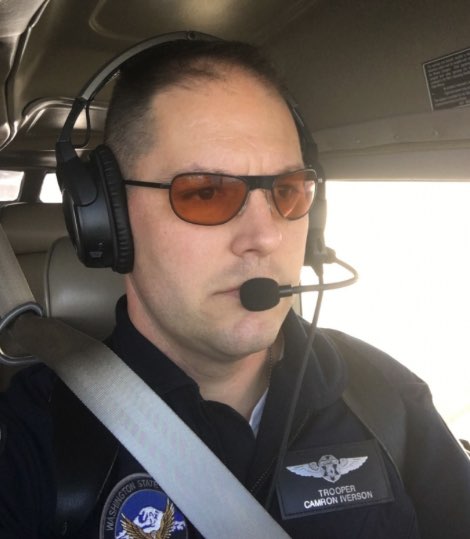
Flight Officer Camron Iverson of the Washington State Patrol tested laser protection lenses formulated at AFRL’s Materials and Manufacturing Directorate. (Photo by Mary Pacinda)
The Personnel Protection Team in AFRL’s Materials and Manufacturing Directorate, headed by Dr. Matthew Lange, used the cockpit compatibility design software developed for Department of Defense LEP and modified it for commercial use. The commercial version, called CALI (Commercial Aviation Low Intensity) filters out the laser light, but not the light coming from the pilot’s instrument panel. “Simply put,” said Lange, “the lenses maximize protection while minimizing the impact to the cockpit.”
China: "Laser AK-47" assault rifle said to be manufactured; experts skeptical
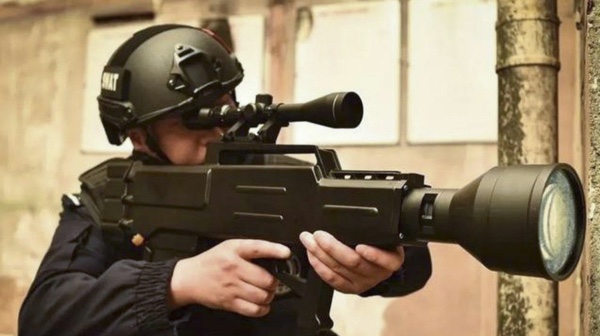
The July 1 2018 report appeared the In South China Morning Post. It quoted a “researcher who had [taken] part in the development and field testing of a prototype at the Xian Institute of Optics and Precision Mechanics at the Chinese Academy of Sciences in Shaanxi province. The source said “The pain will be beyond endurance.” Another researcher said that because the beam is invisible and noiseless, “nobody will know where the attack came from. It will look like an accident.”
A technical document stressed the “non-lethal” nature of the laser rifle, listing attacks such as burning the banners or clothing of “illegal protests”.
The laser capability claims were disputed, however, by numerous news outlets.
TechCrunch writer Devin Coldewey first noted that military laser systems capable of delivering damaging heat over hundreds of meters require “on the order of tens of kilowatts, and those have trouble causing serious damage.” He calculated that a Tesla Powerwall using lithium ion batteries produces a few kilowatts of power and weighs over 200 pounds. (The complete laser rifle weighs 6.6 pounds.) Coldewey said the problem was atmospheric attenuation of the laser beam which is “non-trivial at anything beyond, say, a few dozen meters. By the time you get out to 800 [meters, the laser’s claimed range] the air and water the beam has traveled through [are] enough to reduce it [to] a fraction of its original power.”
Israel: Laser-equipped drones to fight incendiary kites and balloons
From late March to mid-June 2018, 450 fires caused by the aerial attacks burned about 7,500 acres of farmland and national parks, including 1,400 acres of wheat.
In response, the IDF has developed systems to locate the kites and balloons, either intercepting them or sending fire fighters to the landing locations. One interception technique uses a laser on a drone that in tests “has been successful in incinerating the incoming trajectory, neutralizing it and bringing it down.” It is expected to be deployed “soon” according to news stories in late June 2018.
From the JewishPress.com, L.A. Times, and The Times of Israel
US: Marines to buy 1,653 eye-safe laser dazzlers
- An infrared (1535nm) laser rangefinder determines the distance to a person or object. The closer the distance, the lower the laser power output.
- Near-field detection shuts off laser emission if a person or object is too close to the laser output aperture.
- A 3-axis gyroscope detects motion. If the Glare Recoil is suddenly moved, the laser shuts off until stability is resumed and an accurate determination of the distance to a person or object can be re-established: “This prevents hazardous irradiance in situations where Glare Recoil is moving faster than the laser rangefinder can detect objects and dose power output. This results in the prevention of eye hazard danger caused by rapid movement of the device (example: flagging) or improper situational awareness of the operator.”
With these technologies, the laser detects objects or people in the proximity of the beam and then self-adjusts the power output to maintain eye safety. The Nominal Ocular Hazard Distance is said to be 0 meters; the range is 10 feet to 10 miles.
Suggested uses include urban patrolling, cordon and search, crowd control, clearing facilities and security checkpoints.
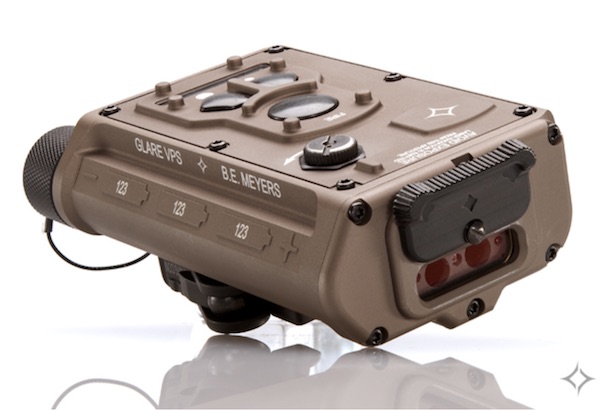
The Glare Recoil is about the size of a Walkman tape player at 5.5” x 3” x 2”. It can mount on a rifle or be handheld.
Meyers also sells a Class 1M “Glare Helios” which has an FDA variance allowing sales to U.S. local, state and federal law enforcement, and U.S. flagged vessels.
From Marine Corps Times, Soldier Systems, and B.E. Meyers. A video produced by the company goes into detail about the specifications and how the person/object detection works.
US: Air Force wants 38,000 more laser eye protection glasses and visors
While the original draft RFP was published for comments on March 27 2018, the revised request takes on additional urgency after the Pentagon on May 3 2018 accused China of aiming lasers at aircraft flying from a U.S. airbase in Djibouti. According to the Pentagon, two pilots had minor, short-term injuries as a result. The next day, China denied using lasers against aircraft in Dijibouti, calling them “groundless accusations.”
The current provider of the Air Force’s laser protection is Teledyne Scientific & Imaging, which was awarded a $30.1 million contract in July 2016 for 11.805 Aircrew Laser Eye Protection (ALEP) Block 2 glasses. The May 2 2018 RFP is for Block 3 glasses and visors. and will provide protection both during the day and at night from laser light.
The RFP’s Requirements Matrix does not specify the exact wavelengths to be blocked. It does say that the night version must have at least 50% visibility (Photopic Luminous Transmittance) and at least 14% for day versions. The document also states:
The ALEP Block 3 will not impair visual performance to the extent that it interferes with safety of flight or mission completion. The device will be visually compatible with the following devices/activities:
- All USAF aircraft
- Joint Helmet Mounted Cueing System (JHMCS); Night Vision Goggles (NVG); Panoramic Night Vision Goggles (PNVG), Helmet Mounted Integrated Targeting (HMIT/HoBiT), and fielded/post- Milestone B visors and aircrew chemical warfare masks
- Canopies/windscreens, HUD, and color cockpit displays
- Detection, recognition, identification, and tracking of targets
- Ability to distinguish terrain colors and geographical features
- Cockpit interior lighting, external aircraft lights, and airfield lights
- Ability to read charts, maps, and other printed materials in the cockpit
- Ability to perform normal aircraft duties in cockpit
From Jane’s 360 and the Air Force Aircrew Laser Eye Protection Block 3 IDIQ Draft RFP. When navigating the FRP webpage, note that there is the Original Synopsis dated March 27 2018 and the “Changed” version dated May 2 2018. There may be subsequent versions as well. The Statement of Work and the Requirements Matrix are the primary documents in the RFP.
Ukraine: Developing countermeasures after 4 cases of laser eye injury
“We already had several such cases (a laser injury of the eye retina) in the State Border Guard Service and in the National Guard. We are now developing countermeasures. We do not fully understand what they use, but we are already working on the instructions what it could be. We will install the appropriate filters, devices, use appropriate glasses,” Avakov said.
He reported on four cases of the laser injury of border guards and national guardsmen.
“The use of such weapons is a barbarous situation. We will discuss it at the international level,” Avakov emphasized.
From Kyiv Post
US: Navy tests green beam across Chesapeake Bay
The information was released to help reassure any residents who might see the beam. The Navy called the beam “eye-safe” and said the beam would be turned off if an aircraft or watercraft is within 300 meters.
The purpose of the test is to “evaluate the performance of a laser system at long range over water,” according to a spokesperson. The laser would be aimed from the source to a target as far as 13 miles away.
There was speculation that the laser was 150 kilowatts, based on an earlier speech by the vice chief of naval operations. However, the spokesperson said the June 27 test would not be using the 150 kW laser.
From the Baltimore Sun, WTOP and the town of Morningside, Maryland
US: Anti-laser laser for drone defense
To help defend drones against laser light, a California company has developed a defensive laser to be mounted on the drone. When it detects a laser attack, it first analyzes the incoming beam’s power, wavelength, pulse frequency and source. It then uses its own laser to counter the incoming beam.
The exact method is secret. New Scientist speculates “…it may involve fooling the control system into thinking it is hitting its target despite the laser actually pointing a few metres to the side. A direct hit would have produced a big burst of reflected light, so a pulse sent back by an anti-laser laser could make it look like the original laser was on target.”
The company is Adsys Controls of Irvine, California; the anti-laser laser system is called Helios. According to the company, “Helios is a low SWaP [Space, Weight and Power], completely passive Counter Directed Energy Weapon system capable of nullifying the enemy’s DEW [Directed Energy Weapon]. Consisting of a small UAV-mounted sensor package, Helios provides full analysis of the incoming DEW beam including localization and intensity. With this information it passively jams the enemy, protecting the vehicle and the payload.”
From Popular Science and New Scientist
US: Coast Guard seeks FDA waiver; wants to use laser illuminators on helicopters
Currently, the U.S. Department of Defense is permitted to self-certify their laser equipment and usage. The DoD’s Army, Air Force and Navy agencies do not need FDA approval of their helicopter-based laser illuminators. However, the Coast Guard is part of the Department of Homeland Security, which does not have a self-certification waiver. The Coast Guard must currently apply for FDA approval.
On April 14 2016, Rep. Duncan Hunter sent a letter to FDA, asking that the Coast Guard be permitted to self-certify their laser systems. Hunter called FDA’s policy “onerous and burdensome”.
One issue may be that the helicopter-based video system already has low-light and infrared capabilities. Although the laser illumination can further enhance the image, it may not be considered a necessity for operations.
From Seapower magazine
China: Military is equipped with blinding laser weapons
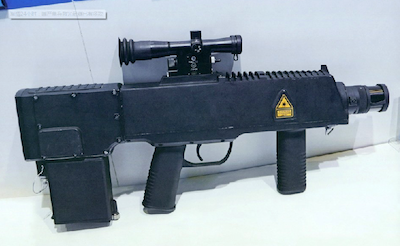
BBQ-905 Laser Dazzler Weapon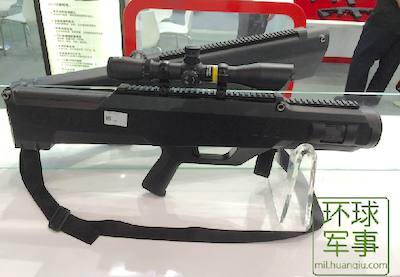
PY132A Blinding Laser Weapon
China’s use of the weapons appears to violate the 1998 Protocol on Blinding Laser Weapons, which China has agreed to follow. A Washington Free Beacon article quoted an expert on Chinese weapons as saying “There is a strong possibility these new dazzlers are being marketed for foreign sale.”
From China Military Online via the Washington Free Beacon. Additional photos showing the weapons and how they would be used are at Huanqui.com.
US: Lockheed Martin demos laser that can burn holes in rubber boats from a mile away
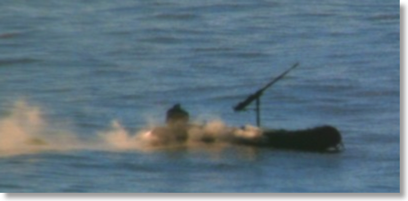
A YouTube video shows infrared and visible footage of the test.
The 10-kilowatt High Energy Laser (HEL) system previously demonstrated an ability to track, target and destroy rockets traveling at high speed.
From Gizmag and Engadget
Israel: Lasers on airplanes used to deflect missiles
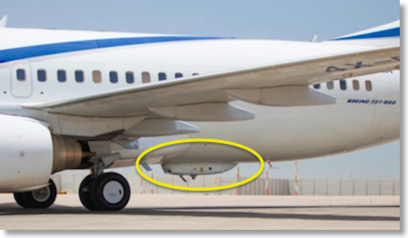
The C-MUSIC system mounted on a Boeing 737-800
The system was developed after a 2002 incident in Kenya where terrorists fired two surface-to-air missiles at an Israeli charter plane carrying more than 250 passengers; the missiles missed their target. C-MUSIC will be added to all El Al aircraft. In addition, the developer Elbit Systems has contracts with other countries besides Israel.
From Wired via Ubergizmo
US: Laser aimed from aircraft to ground results in dozens of calls
In a September 16 2013 article, HawaiiNewsNow said there were “dozens” of inquiries about the nighttime green light. One person emailed that the aircraft circled his area about six times at 1:00 am, with a wide green laser that appeared to be scanning downward. Another email confirmed the multiple passes with a V-shaped green laser.
The Army Corps of Engineers is conducting the work. They stated that the laser is not harmful to the eyes. The Oahu work should take about a week, and mapping the entire state should conclude in November.
From HawaiiNewsNow. Similar flyovers using visible green lasers have occurred in other U.S. cities, such as New York City in 2010 and 2012, according to a a brief Google search of such reports, for example here and the comments here.
US: $208 million contract to protect Army helicopters from laser threats
The Army/Navy Piloted Aircraft/Visual and Visible Light/Receiving, Passive Detecting (AN/AVR-2B) Laser Detecting Sets (LDS) uses four sensor units placed on the aircraft. It is smaller, lighter and uses less power than a previous generation developed for the cancelled Comanche helicopter program.
News reports did not state how much it costs to equip each helicopter with an AN/AVR-2B system.
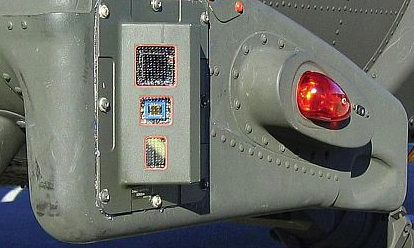
One of the four sensor packages to detect laser threats on U.S. military helicopters
From Avionics Intelligence August 31 2013 and September 3 2013
Worldwide: Laser weapons 10-20 years away from widespread deployment
One speaker noted “…we have had kinetic weapons for 500 years and laser weapons for 10-15 years…. The soldier wants a reliable, easy-to-handle, clear to understand system that has the reliability of a normal M16 rifle, or whatever, therefore the superiority is on the kinetic side.”
From Optics.org
General interest: Article discusses pros and cons of laser sights for weapons
Author John Wills notes that laser sights are not as effective beyond 20 feet, and they do not substitute for marksmanship techniques such as grip and stance.
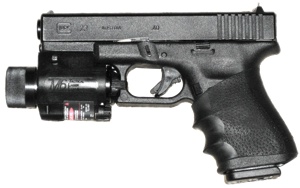
Glock Model 23 with M6 Tactical Laser Illuminator (xenon light plus red laser pointer < 5 mW).
Image from nukeit1 at Flickr, CC by 2.0 license.
Green laser sights are now available; they are more easily seen than an equivalent-power red laser. Infrared laser sights are made for use with night vision goggles. The beam cannot be seen by the naked eye, so a bad guy does not even know he is being targeted.
Wills concludes by saying “like any other tool there is a right way and a wrong way to use” lasers.
From Officer.com
US: First laser dazzler FDA-approved for non-military police

Range diagram from a PDF product brochure for the GLARE Enforcer laser dazzler
While the nominal ocular hazard zone (NOHD) at full power is 130 feet, the device includes a safe, low-power laser that measures the distance to a person or reflective object, and lowers the light level so it is safe at the detected distance. Military dazzlers do not have such a feature, relying instead on training soldiers not to aim the laser at persons closer than the hazard distance.
Laser journalist Jeff Hecht reported in a February 13 2012 article that there have been “some injuries” from military dazzlers, most of them minor. He also noted that ordinary citizens armed with laser pointers could be more of a hazard than police or military dazzlers. For example, lasers were used against police in Greece during riots in June 2011.
From New Scientist. The B.E. Meyers Electro-Optics GLARE Enforcer product page is here.
US: Air Force spending $2,400 each, for 3,000+ laser protection glasses
[NOTE: The amounts above represent about $2,400 per pair of laser protection spectacles. More information about anti-laser glasses for pilots, including non-military versions protecting against one or two visible wavelengths for roughly $100-200, is here.]
From a Teledyne Technologies press release
Worldwide: Concern over laser dazzling of satellites
“There are lasers used to hit satellites, it’s called dazzling, and it’s a show of force. There are a handful of countries that can do it. China dazzles U.S. and French satellites in low earth orbit not often, but regularly. What if a laser hits them, maybe lingers too long? A show of force can actually damage the satellite, knocks out some sensitive equipment. If that happens, and it’s from China, is that an act of war? What do you do? Political leaders have to be briefed on this. They have to make an effort to avoid escalation.”
From an interview in the Santa Barbara Independent conducted by Kevin Zambrano
US: Military aircrews can use finger-mounted laser pointers for target identification
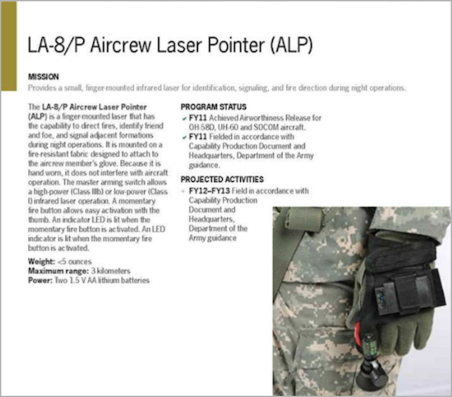
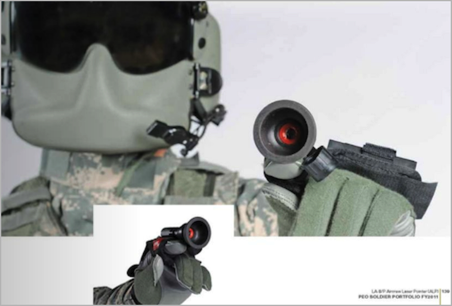
For the military laser enthusiast, the catalog contains a number of other laser devices such as the AN/PEQ-14 Integrated Laser White Light Pointer (actually a white flashlight plus a visible and an invisible laser):
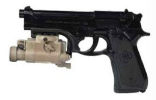
From the Program Executive Officer Soldier Portfolio FY2012 catalog. The LA-8/P is on printed pages 138-139, electronic pages 146-147. Originally found via GovWin.
Commentary from LaserPointerSafety.com: Although the LA-8/P Aircrew Laser Pointer does not emit a visible beam, it would be easy to make a visible version so that aircrews could “fire back” at persons on the ground aiming laser pointers at them. Whether this is a wise idea is another matter.
.
US: Airborne missile-killing laser project mothballed after $5 billion
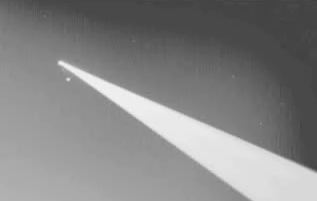
Cockpit view of the ABL shooting down a missile on Feb. 11 2010. Video is here.
A key reason for the ABL shutdown was the cost of the project versus the projected military returns. Another reason is that the Missile Defense Agency is looking to a new generation of laser systems with “much denser capacity or greater power lasers in smaller packages and operating at much higher altitudes.” Unmanned aerial vehicles would be an ideal platform. The MDA’s director said antimissile drones using solid-state lasers could be a reality by 2020.
From Aviation Week. An analysis of laser weapons is at Strategy Page.
Commentary from LaserPointerSafety.com: We included this story because people sometimes wonder if lasers aimed from the ground can damage an aircraft’s airframe. The short answer is “no”. It would take a system similar to the $5 billion ABL. However, the Missile Defense Agency is now indicating that military-developed solid-state lasers may be able to cause enough damage to down a missile -- or aircraft -- within this decade (the 2010s).
While it is unlikely that non-state groups could deploy such a device, it is more of a possibility than independently developing an ABL-like COIL gas laser. For the foreseeable future, the threat to aircraft remains the visual impairment caused by bright laser light, and to a lesser degree, the possibility of causing retinal lesion eye injuries.
.
US: Report says Iran blinded CIA satellite with laser
This was the only laser-related information in a December 15 2011 article that was otherwise about Iran tricking a U.S. drone into landing in Iran by jamming its GPS position signals.
From the Christian Science Monitor; the laser paragraph was on page 2 of the online story. See also an October 2011 Washington Post story analyzing a politician’s claim that China blinded U.S. satellites in 2006.
.
UK: Police dazzler laser being tested to flashblind rioters
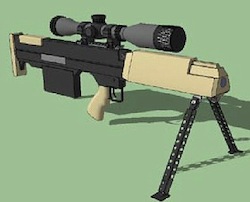
Concept of the rifle, from the Daily Mail
The developer is Photonic Security Systems, which also markets the rifle as a pirate deterrent. The Telegraph says that similar devices have been used in Afghanistan by NATO-led International Security Assistance Force troops.
PSS managing director Paul Kerr told the International Business Times "The very purpose of this technology is to be non-damaging … If someone is prepared to just stand there and stare down the barrel at this, which would be incredibly uncomfortable, then they are definitely a threat.” He said that he has often been exposed to the laser: "The quality and safety of the device is paramount and I know that first hand because I have been the guinea pig many times. I know what it is like and I know how effective it can be."
Author and activist Cory Doctorow points out that “the UK is a signatory on the Protocol on Blinding Laser Weapons … this weapon wouldn’t run afoul of international law if it (merely) reduced your vision to the point where you were impaired but not legally blind, permanently.” Doctorow also says “Twitter wags are already predicting a resurgence of mirrorshades [reflective sunglasses] among protesters.”
From the Telegraph, the Daily Mail, the International Business Times and BoingBoing. See related story on BAE Systems anti-pirate dazzler.
.
US: Politician says China blinded U.S. satellites with lasers
US: Military helicopters may use lasers to fight ground-based attacks
Black Hawk and Chinook helicopters have been testing a acoustic detection system called “Helicopter Alert and Threat Termination”, or HALTT. This uses microphones to detect the sound of a bullet or RPG. Delays in the sound reaching the microphones enables them to determine the sound’s location. A similar truck-mounted system is already in use. It can automatically swivel and fire a gun in the direction of the sound.
For helicopters, HALTT can be combined with guns and/or lasers. Infrared lasers help confuse missile guidance systems, while visible lasers would dazzle and flashblind anyone aiming at the helicopter. An engineer said the principle is to “make it impossible for a human to observe your aircraft … by creating a distracting light source. That has been done in the past and is a proven technology…”. The HALTT/laser countermeasure system could be in use by 2017.
The military already uses laser dazzlers at checkpoints, to warn approaching vehicles and to cause glare on anyone taking aim at soldiers.
From Wired and Defense Tech. A video of how the IR system would work against a missile is at YouTube.
US: Pentagon delayed using laser dazzers in Iraq
During the U.S. phase of the Iraq war, Marine Corps leaders requested the handheld devices as a way to warn and stop drivers who were overrunning military checkpoints. Wired’s David Axe estimates that “as many as 50” Iraqi civilians were killed by gunfire -- instead of being forced off the road by dazzlers -- during the nine month delay.
There is some dispute over the safety of laser dazzlers. According to the Inspector General’s report,
Laser dazzlers provide a nonlethal capability by emitting an intense light capable of temporarily obscuring the vision of approaching individuals; however, using lasers poses a risk of serious eye injury and permanent blindness. This mode of employing a laser, shining a laser directly into the face or eyes, increases the inherent dangers of using the laser. Using nonlethal laser dazzlers would give Marine operating forces an additional capability to increase stand-off distances, safeguard civilians who venture too close to Marine positions, and help prevent unwarranted escalation of force incidences; however, DoD [Department of Defense] policy prohibits the use of lasers designed to cause permanent blindness. Operating procedures and laser safety measures are essential to ensure the safe and proper use of the lasers.
The Inspector General’s report contains additional details about the range, capabilities, safety concerns and policy issues related to military use of laser dazzlers. For example, the 1995 Protocol on Blinding Laser Weapons states that the signatories (which include the U.S.) “shall take all feasible precautions to avoid the incidence of permanent blindness to unenhanced vision.”
From Wired.com.
UK: Laser "dazzler" from BAE Systems for use against pirates and other threats
Roy Clarke, BAE Systems capability technology lead for laser photonic systems, said: “The effect is similar to when a fighter pilot attacks from the direction of the sun. The glare from the laser is intense enough to make it impossible to aim weapons like AK47s or RPGs, but doesn’t have a permanent effect.”
From the BAE Systems press release.